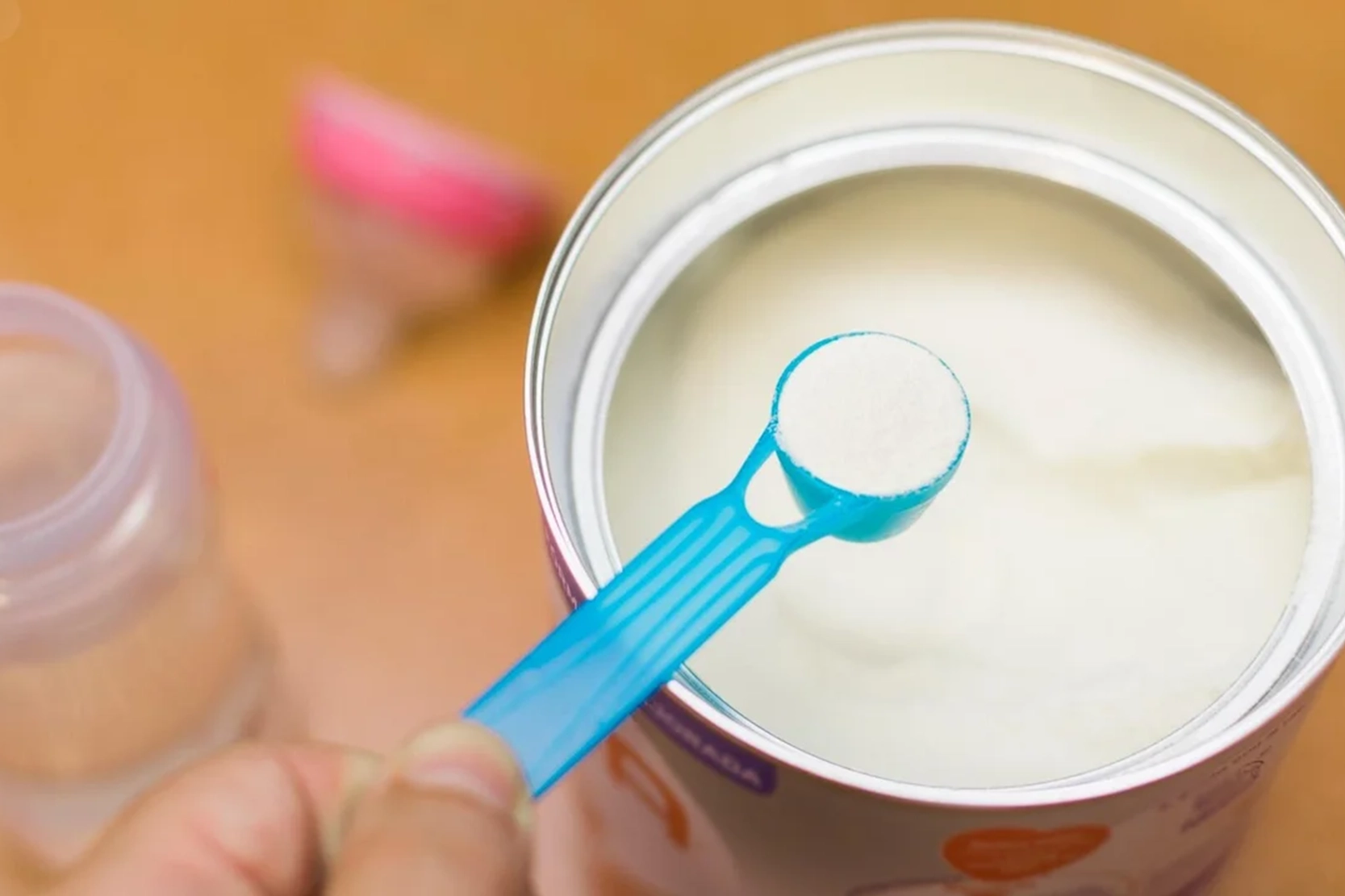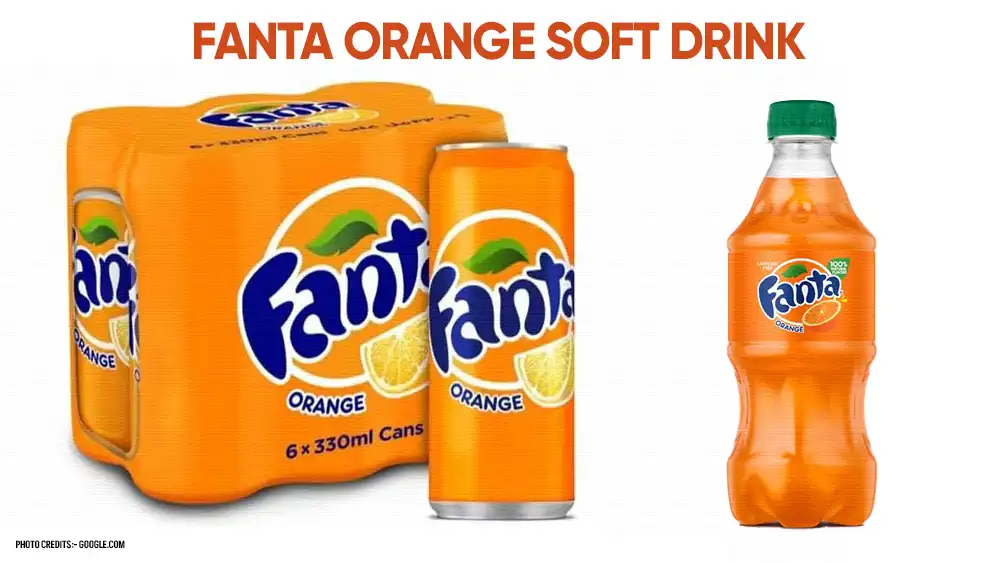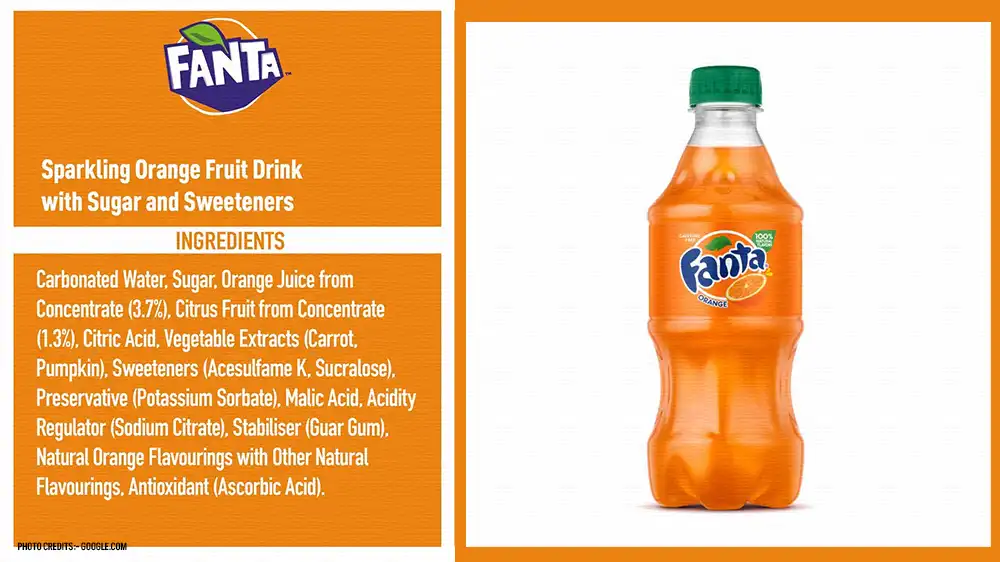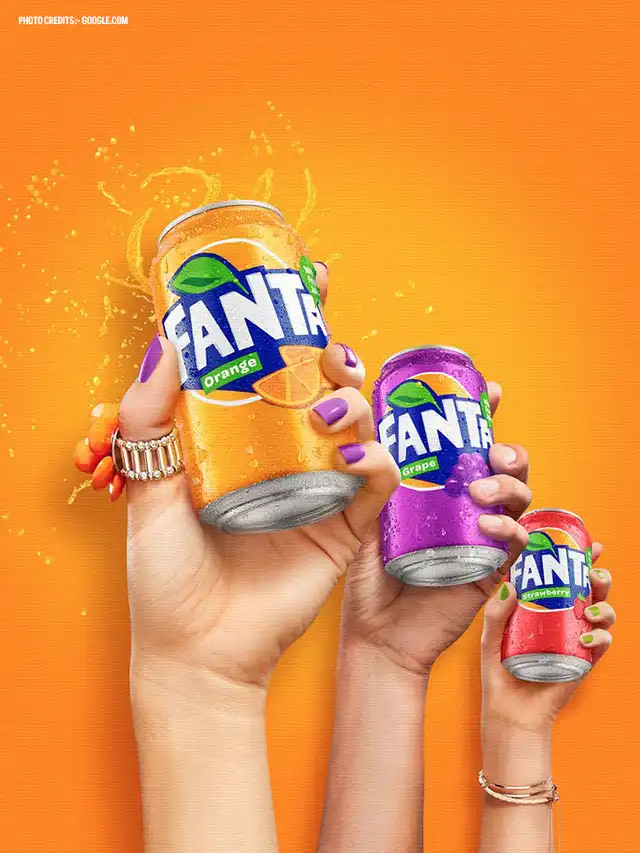
HEALTH BLOG
Fanta Orange Soft Drink: Refreshing Citrus Flavor Explained
-
Rahul Priydarss
Delve into the captivating story of Fanta Orange Soft Drink—a beloved carbonated beverage renowned for its zesty citrus taste and vibrant orange hue. From its innovative origins during World War II to its evolution as a global icon under The Coca-Cola Company, explore the ingredients, cultural impact, and sustainability initiatives behind this refreshing favorite. Discover why Fanta Orange continues to charm consumers worldwide with its fizzy refreshment and enduring appeal, making it a staple in households and gatherings alike.
Introduction Fanta Orange Soft Drink:
Fanta Orange, the effervescent citrus-flavored soft drink, has long held a special place in the hearts of soda enthusiasts worldwide. Its vibrant color, zesty flavor, and refreshing fizz make it a favorite among both the young and the young-at-heart. But what is it about Fanta Orange that sets it apart from other soft drinks? This blog post delves into the history, production process, marketing strategies, and cultural impact of Fanta Orange, offering a comprehensive exploration of this beloved beverage.
What is Fanta Orange Soft Drink:
Fanta Orange is a popular carbonated soft drink known for its bright orange color and refreshing citrus flavor. It is one of the many flavors produced under the Fanta brand, which is owned by The Coca-Cola Company. Fanta Orange is sweetened and fizzy, providing a tangy and invigorating taste that appeals to a wide range of consumers. First introduced in the 1940s, Fanta Orange has become a beloved beverage worldwide, often associated with fun, youthfulness, and enjoyment. It is available in various packaging options, including cans, bottles, and multi-packs, making it a convenient choice for individuals and groups. Fanta Orange is commonly enjoyed on its own or used as a mixer in cocktails and mocktails.

Table of Contents
The History of Fanta Orange Soft Drink:
Fanta Orange has a rich and intriguing history that dates back to the challenging days of World War II. The story begins in 1940 in Nazi Germany, where Coca-Cola GmbH, the German subsidiary of The Coca-Cola Company, faced significant difficulties due to trade embargoes that cut off the supply of Coca-Cola syrup. Max Keith, the head of Coca-Cola GmbH at the time, decided to create a new product using available ingredients to keep the business afloat. Thus, Fanta was born.
The name “Fanta” was derived from the German word “Fantasie,” meaning “imagination,” which aptly described the innovative approach taken to create the beverage. The original Fanta was made from byproducts of the food industry, such as whey and apple pomace, due to the scarcity of ingredients. This early version of Fanta was quite different from the Fanta we know today.
After the war, Fanta was discontinued, but the brand was revived in the 1950s. This time, The Coca-Cola Company decided to reformulate Fanta and market it as a fruit-flavored soda. The reformulation process involved creating a variety of fruit flavors, with orange emerging as the most popular and enduring choice. By the late 1950s, Fanta Orange had established itself as a staple in the soft drink market.
Throughout the following decades, Fanta Orange Soft Drink expanded its reach globally. Its vibrant color, refreshing taste, and clever marketing campaigns helped it gain popularity across different countries and cultures. One notable marketing effort was the introduction of the “Fantanas” in the 2000s, a group of spokesmodels who promoted the fun and playful image of Fanta.
Fanta’s branding and advertising have always emphasized youthfulness, fun, and spontaneity. Campaigns like “More Fanta, Less Serious” resonated with younger audiences, further cementing Fanta Orange as a beloved beverage. In addition to traditional media, Fanta embraced digital marketing and social media, engaging with consumers through interactive posts, creative challenges, and influencer collaborations.
In recent years, Fanta has continued to innovate by introducing new flavors, reducing sugar content, and exploring healthier alternatives to meet changing consumer preferences. The brand’s commitment to sustainability has also seen efforts to use recycled materials in packaging and improve manufacturing processes to minimize environmental impact.
Today, Fanta Orange remains one of the most popular and recognizable soft drinks worldwide. Its history is a testament to the power of innovation, adaptation, and effective marketing in creating a lasting and beloved brand. Whether enjoyed on a hot summer day, at a festive event, or as part of a creative recipe, Fanta Orange continues to bring joy and refreshment to millions of people around the globe.
Ingredients of Fanta Orange Soft Drink:
Fanta Orange is a carbonated soft drink known for its vibrant orange color and tangy citrus flavor. The exact ingredients may vary slightly depending on the region, but the standard ingredients for Fanta Orange generally include the following.
Carbonated Water: This is the primary ingredient, providing the fizzy, refreshing base of the drink.
High Fructose Corn Syrup (or Sugar): This sweetener gives Fanta its characteristic sweet taste. Some versions use cane sugar instead of high fructose corn syrup.
Citric Acid: This ingredient provides the tart, citrus flavor that is essential to Fanta Orange.
Natural Flavors: These are derived from fruits and other natural sources to enhance the citrus taste.
Sodium Benzoate: This preservative helps to maintain the drink’s freshness and extend its shelf life.
Color (Yellow 6 and Red 40): These artificial colors give Fanta Orange its bright, appealing color.
Modified Food Starch: This is used to stabilize the flavor and maintain the texture of the drink.
Glycerol Ester of Wood Rosin: This ingredient helps to keep the flavors evenly distributed throughout the beverage.
Brominated Vegetable Oil (BVO): This is sometimes used to stabilize the citrus flavor, although its use varies by region due to regulatory differences.
Certainly! Here is a table outlining the typical ingredients found in Fanta Orange and their approximate quantities:
| Ingredient | Quantity per Serving (12 fl oz/355 ml) |
|---|---|
| Carbonated Water | 240 ml (8 fl oz) |
| High Fructose Corn Syrup | 39 grams |
| Citric Acid | 0.6 grams |
| Natural Flavors | Small amount |
| Sodium Benzoate | 0.04 grams |
| Color (Yellow 6 and Red 40) | Small amount |
| Modified Food Starch | Small amount |
| Glycerol Ester of Wood Rosin | Trace |
| Brominated Vegetable Oil (BVO) | Trace |
Please note that the exact quantities of some ingredients, especially additives like colors and stabilizers, can vary slightly based on manufacturing processes and regional regulations. It’s always advisable to refer to the specific product label for precise ingredient information.
Nutritional Information of Fanta Orange Soft Drink:
Here is the typical nutritional information for Fanta Orange, based on a serving size of 12 fluid ounces (355 ml).
| Nutrient | Amount per Serving |
|---|---|
| Calories | 160 |
| Total Fat | 0 g |
| – Saturated Fat | 0 g |
| – Trans Fat | 0 g |
| Sodium | 65 mg |
| Total Carbohydrates | 44 g |
| – Dietary Fiber | 0 g |
| – Sugars | 44 g |
| Protein | 0 g |
Please note that the nutritional values may vary slightly depending on the specific formulation of Fanta Orange and regional variations. It’s important to check the product label for the most accurate and up-to-date nutritional information.
The Production Process of Fanta Orange Soft Drink:
Creating the perfect Fanta Orange involves a meticulous process that ensures every bottle is bursting with the signature flavor and effervescence. The key ingredients in Fanta Orange include carbonated water, high fructose corn syrup (or sugar in some regions), citric acid, natural flavors, sodium benzoate, and artificial colors.
Water Treatment: The process begins with the purification of water. This step is crucial as the quality of water can significantly affect the taste of the final product. The water undergoes filtration and treatment to remove any impurities.
Syrup Preparation: The next step involves creating the syrup base. High fructose corn syrup or sugar is mixed with citric acid, which provides the tangy taste. Natural flavors, derived from orange essence, are added to give Fanta its distinctive citrus flavor.
Mixing: The syrup is then mixed with carbonated water. This is done using high-pressure carbon dioxide to ensure the right level of fizz. The mixture is cooled to a specific temperature to maintain carbonation.
Coloring and Preservatives: Artificial colors are added to achieve Fanta’s bright orange hue, making it visually appealing. Sodium benzoate is used as a preservative to extend shelf life.
Bottling and Packaging: The final product is bottled and sealed to preserve freshness. The bottles are then labeled and packaged for distribution.

Global Variations of Fanta:
Fanta Orange, a beloved carbonated soft drink known for its citrusy flavor and vibrant color, exhibits variations across different regions worldwide. While the core essence of Fanta Orange remains consistent, variations in ingredients, formulations, and even branding can be observed based on local preferences and regulatory requirements.
Fanta is a popular brand of carbonated soft drinks known for its variety of flavors, each offering a unique taste experience. While Fanta Orange remains one of the most iconic flavors, the brand has expanded to include a diverse range of other flavors to cater to different consumer preferences and regional tastes. Some of the notable Fanta flavors include:
Fanta Grape: Known for its sweet and fruity grape flavor, Fanta Grape offers a refreshing alternative to traditional citrus sodas.
Fanta Pineapple: This tropical flavor combines the sweetness of pineapple with the fizzy goodness of Fanta, providing a tropical escape in every sip.
Fanta Strawberry: With a blend of sweet and tangy strawberry flavors, Fanta Strawberry is a popular choice for those who enjoy fruity sodas.
Fanta Berry: Combining the flavors of various berries, Fanta Berry offers a burst of berry goodness in every refreshing sip.
Fanta Apple: Crisp and refreshing, Fanta Apple delivers a delightful apple flavor that is both sweet and tart.
Fanta Mango: Known for its exotic mango flavor, Fanta Mango provides a taste of the tropics with every fizzy sip.
Fanta Watermelon: Refreshing and summery, Fanta Watermelon captures the essence of juicy watermelon in a carbonated beverage.
The Environmental Impact of Fanta:
Fanta, like many other beverage brands, has an environmental impact that spans various aspects of its production, packaging, and consumption. Here are some key considerations regarding Fanta’s environmental impact.
Packaging: Fanta is primarily packaged in plastic bottles and aluminum cans. While both materials are recyclable, plastic waste, in particular, poses significant environmental challenges due to its persistence in the environment and potential for marine pollution. The Coca-Cola Company, which owns Fanta, has committed to increasing the use of recycled materials in its packaging to reduce the demand for new plastics and lower its overall environmental footprint.
Water Use: Beverage production requires significant amounts of water for ingredient processing, beverage manufacturing, and cleaning processes. Water usage can strain local water sources, especially in water-stressed regions where Fanta is produced.
Carbon Footprint: The production and distribution of Fanta contribute to carbon dioxide emissions, primarily through energy consumption in manufacturing plants and transportation. Efforts to reduce Fanta’s carbon footprint include improving energy efficiency in production facilities, optimizing transportation logistics, and exploring renewable energy sources.
Waste Management: Waste management is crucial in minimizing the environmental impact of Fanta. Proper disposal and recycling of bottles and cans help reduce landfill waste and promote a circular economy where materials are reused.
Sustainable Practices: The Coca-Cola Company, as part of its sustainability goals, has implemented initiatives to promote sustainable sourcing of ingredients, reduce water usage, and improve recycling rates globally. Fanta and its parent company are also involved in community-based environmental projects and partnerships aimed at promoting environmental awareness and conservation efforts.
Consumer Awareness and Responsibility: Encouraging consumers to recycle Fanta packaging properly and minimize single-use plastics can significantly reduce the environmental impact of the beverage. Promoting awareness of sustainable consumption practices, such as choosing beverages with eco-friendly packaging or opting for reusable bottles, further supports environmental conservation efforts.
Health Considerations of Consuming Fanta Orange Soft Drink:
When considering the health implications of consuming Fanta or any sugary soft drink, several factors should be taken into account.
Sugar Content: Fanta, like many soft drinks, contains a significant amount of sugar. A 12-ounce serving of Fanta Orange, for example, typically contains about 44 grams of sugar. Consuming high amounts of added sugars can contribute to weight gain, dental cavities, and may increase the risk of chronic diseases such as type 2 diabetes and heart disease.
Caloric Intake: Fanta is also calorie-dense due to its sugar content. A 12-ounce serving of Fanta Orange provides around 160 calories, primarily from sugars. Regular consumption of sugary beverages like Fanta without compensating by reducing calorie intake from other sources can lead to weight gain over time.
Nutrient Deficiency: Drinking sugary beverages like Fanta may displace nutrient-dense foods and beverages from the diet, potentially leading to nutrient deficiencies if not balanced with a healthy and varied diet.
Dental Health: The high sugar content in Fanta and other soft drinks can contribute to dental erosion and cavities, especially when consumed frequently and in large amounts.
Hydration: While Fanta is a liquid, it should not be considered a substitute for water or other hydrating beverages. Water remains the best choice for maintaining proper hydration without additional calories or sugar.
Alternative Options: Considering health implications, opting for Fanta’s lower-calorie or sugar-free alternatives, when available, can be a better choice for those looking to reduce sugar intake while still enjoying a flavored carbonated drink.
Moderation: Enjoying Fanta or similar beverages in moderation, as an occasional treat rather than a daily beverage choice, can help mitigate potential health risks associated with excessive sugar consumption.
USA Consumer Reviews and Feedback:
Consumer reviews and feedback regarding Fanta in the USA are diverse and reflect a range of perspectives based on individual preferences and experiences. Here are some common themes and sentiments found in consumer reviews.
Flavor Enjoyment: Many consumers appreciate the bold and refreshing flavors of Fanta, particularly Fanta Orange. The tangy citrus taste and fizzy texture are often highlighted as enjoyable and satisfying, making it a popular choice for those seeking a flavorful soft drink.
Nostalgia and Brand Loyalty: Fanta often evokes nostalgia among consumers, especially those who grew up enjoying the beverage. This nostalgic connection contributes to strong brand loyalty, with some consumers expressing fond memories associated with Fanta from childhood and continuing to choose it as their preferred soft drink.
Variety and Innovation: Consumers appreciate Fanta’s wide range of flavors beyond Orange, including Grape, Pineapple, and Strawberry, among others. The variety allows consumers to explore different tastes and find flavors that suit their preferences.
Marketing and Brand Image: Fanta’s vibrant and playful marketing campaigns resonate with many consumers, particularly younger demographics. Campaigns featuring catchy jingles, colorful advertisements, and engaging social media content contribute to Fanta’s appeal as a fun and youthful brand.
Availability and Accessibility: Fanta’s widespread availability in supermarkets, convenience stores, restaurants, and vending machines across the USA makes it easily accessible to consumers. This convenience factor is often appreciated by those seeking a quick and familiar beverage option.
Customer Service and Packaging: Reviews occasionally mention customer service experiences related to product quality or packaging issues. Consumers value consistency in product taste and quality, as well as sustainable packaging practices.
Fanta Orange Soft Drink Comparisons with Other Soft Drinks:
Comparing various soft drink brands like Fresca, Limka, Coca-Cola, and Monster involves looking at several factors such as taste, ingredients, target audience, and market positioning.
Fresca: Known for its citrus flavor, Fresca is a zero-calorie soda owned by Coca-Cola. It targets health-conscious consumers looking for a sugar-free alternative with a distinct grapefruit taste.
Limca: This is a popular lemon-lime soda in South Asia, similar to Sprite or 7UP. It emphasizes a refreshing citrus flavor and is widely consumed in the region.
Coca-Cola: One of the most iconic soft drinks globally, Coca-Cola is known for its caramel flavor and fizzy texture. It has a broad appeal and is often associated with nostalgia and global marketing campaigns.
Monster: Unlike traditional sodas, Monster is an energy drink that competes in a different segment, targeting young adults and athletes with high caffeine content and various flavors like original, ultra, and rehab.
Why Fanta Orange is Loved by US Citizens:
Fanta Orange, with its vibrant color and refreshing taste, has become a beloved beverage among US citizens. Several factors contribute to its widespread popularity, including its flavor profile, marketing strategies, cultural significance, and more.
Fanta Orange offers a bold, tangy citrus flavor that stands out among other soft drinks. The sweet and slightly tart taste provides a refreshing experience that appeals to a wide range of palates. The carbonation in Fanta Orange adds a fizzy, bubbly sensation that enhances the overall drinking experience. This effervescence is particularly satisfying on hot days or during physical activities. Many Americans associate Fanta Orange with fond childhood memories, family gatherings, and special occasions. This nostalgic connection fosters a sense of loyalty and affection for the brand.
Fanta has successfully positioned itself as a fun, youthful brand. Its vibrant advertising campaigns, catchy jingles, and playful packaging resonate with younger audiences, making it a popular choice among teenagers and young adults. Over the years, Fanta has launched several memorable marketing campaigns in the US. Campaigns like “More Fanta, Less Serious” and the “Fantanas” have become iconic, further solidifying Fanta’s place in popular culture. In the digital age, Fanta has effectively utilized social media to engage with its audience. Interactive posts, creative challenges, and influencer collaborations keep the brand relevant and exciting.
Fanta Orange frequently appears in movies, TV shows, and music videos, often associated with fun and celebration. These appearances help embed the brand into the fabric of American popular culture. Fanta often sponsors music festivals, sports events, and other large gatherings. These sponsorships not only increase brand visibility but also associate Fanta with enjoyable experiences. Fanta Orange is a popular choice during holidays and celebrations in the US. Its bright color and refreshing taste make it a festive addition to gatherings, barbecues, and parties.
Benefits of Drinking Fanta Orange Soft Drink:
Fanta, particularly its flagship Orange flavor, is a widely enjoyed beverage around the world. While it’s important to consume any sugary drink in moderation due to its sugar content, there are certain benefits that people appreciate about drinking Fanta. Fanta Orange is known for its tangy, citrus flavor which provides a refreshing and invigorating drinking experience. The unique taste profile can be particularly enjoyable on a hot day or after physical activity. Additionally, the fizzy nature of Fanta can make it more refreshing than non-carbonated drinks, enhancing the sensory experience and making it a satisfying thirst-quencher.
For many people, drinking Fanta can evoke fond memories of childhood, family gatherings, or fun times with friends. This emotional connection can enhance the overall enjoyment of the beverage. Sharing a bottle or can of Fanta can be a social activity that fosters bonding among friends and family. It’s a common choice for parties, picnics, and other social events, making it a staple in group settings. Fanta is also quite versatile. It can be used as a mixer in various drinks, both alcoholic and non-alcoholic, and its citrus flavor pairs well with other beverages, allowing for creative concoctions. Additionally, Fanta can be used in cooking and baking recipes, adding a unique flavor to dishes. It’s sometimes used in marinades, glazes, and even cakes, providing a sweet and tangy twist.
FAQs about Fanta Orange Sost Drink:
A1: Fanta Orange is a carbonated soft drink known for its bright orange color and tangy citrus flavor. It’s a popular beverage under The Coca-Cola Company’s Fanta brand, enjoyed globally.
A2: Fanta Orange was created in Nazi Germany during World War II when Coca-Cola faced ingredient shortages. It was revived in the 1950s as a fruit-flavored soda, with orange becoming its most iconic flavor.
A3: Fanta Orange typically includes carbonated water, high fructose corn syrup (or sugar), citric acid, natural flavors, sodium benzoate, and artificial colors like Yellow 6 and Red 40.
A4: The Coca-Cola Company, which produces Fanta, is committed to sustainability by increasing recycled materials in packaging and improving manufacturing processes to reduce environmental impact.
A5: Fanta Orange, like other sugary soft drinks, should be consumed in moderation due to its high sugar content. It can contribute to weight gain and dental issues if consumed excessively.

-Please remember, to always consult with healthcare professionals or Doctors for personalised advice related to medical conditions.
Conclusion:
In conclusion, Fanta Orange Soft Drink remains a timeless favorite, celebrated for its tangy citrus flavor, vibrant color, and refreshing fizz. From its innovative beginnings to its global popularity today, Fanta Orange continues to captivate consumers of all ages, embodying a sense of fun and enjoyment in every sip. Its versatile appeal, whether enjoyed solo or as a mixer, underscores its enduring presence in the soft drink market, promising moments of refreshment and nostalgia for generations to come.




